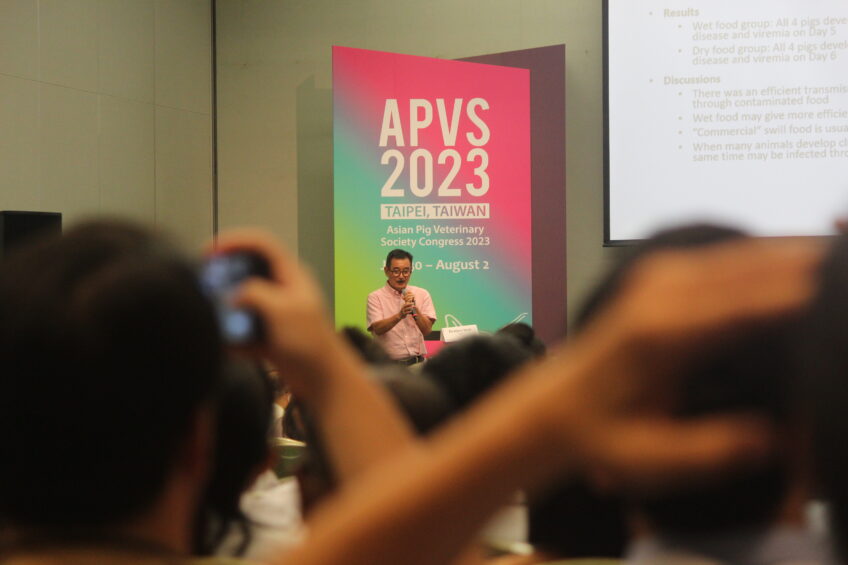APVS Congress: Asian insights about ASF spread

For a few years now Asia has been accustomed to the presence of African Swine Fever. Health-wise, how is the continent preparing for the future? That was a key theme at the Asian Pig Veterinary Society (APVS) Congress, held in late July and early August in Taipei, Taiwan.

Not surprisingly, various keynote lectures at the 2023 APVS Congress were devoted to African Swine Fever (ASF) virus. Kenjiro Inui is Food and Agriculture Organization (FAO) lab consultant at the National Center for Veterinary Diagnosis in Hanoi, Vietnam and as such observed the ASF outbreaks from fairly close by. In his presentation he made various interesting comments – starting off by describing a series of studies that revolved around the question “How is the virus introduced to pig farms?” The aim was to identify dangerous sources as well as dangerous routes of infection.
He discussed trials involving various routes:
Infected animals: Transmission is possible through contact, air or needles. Of these, infection efficiency was estimated to be high with contact and needles. When transmission occurs through contact, it will show by outbreaks initially being limited to pen mates only; whereas when transmission occurs through needles, a group of pigs will develop disease at the same time.
Contaminated feed: Transmission is possible through both swill feeding as well as pelleted feed. An outbreak like this will be characterised by many pigs developing the disease simultaneously.
Contaminated fomites: In this case transmission occurs through either equipment or boots/clothes. He considered infection efficiency of these routes to be low, with outbreaks being limited to one or two pens initially, after which a slow spread would follow.
Contaminated environment: This route includes contamination in the environment or even in an environment after disinfection. For both routes, infection efficiency was estimated to be low, and again limited to one or two pens initially.

ASF market survey
After having discussed the clinical signs of ASF in early, middle and late stages of the disease, he touched on a very interesting market survey. His team of scientists wanted to know which types of markets in Vietnam would have fresh meat products containing ASF virus. They visited large markets (over 20 vendors), small markets and city markets, bought meat and had the meat juice tested for ASF virus.
Quite surprisingly, the study found ASF on the larger local markets. City markets were off the hook, as this is where meat from larger pork producers normally ends up. These farms typically send their pigs to professional slaughterhouses with veterinary inspection, Inui said, which explains why ASF virus was not found much at city markets. Conversely, he said, smaller and medium-sized producers – where the majority of unreported ASF cases happened – would send their pigs to local markets.
Inui said, “First my expectation was that small local markets would have the highest incidence – that if a producer had something that was not good, he would sell it there. But actually, when I asked a Vietnamese friend, he replied: ‘Vendors at a small market are probably your neighbour. Nobody is going to sell sick pigs to their friends. So traders will send the meat mainly to large local markets.’ ”
He suggested starting up an Asia-wide initiative using a similar method to monitor ASF virus occurrence in meat markets, to keep an eye on the prevalence of the virus. He said this would be suitable for a master student, and the results could be shared and reported. The project code would be the “Meat Juice Club”.
Future perspectives: Asia and ASF
He finished by looking into the future and pointing to the development of ASF vaccines in Vietnam by Navetco, AVAC and Dabaco – which will soon also be introduced in other countries throughout South East Asia. He predicted that this will lead to the comeback of smallholders in a relatively short time and that between 2025 and 2030, “ASF would become a preventable disease in domestic pig production”. He added that the number of ASF outbreaks in domestic pigs will be reduced dramatically, while the virus remains in wild boar populations in Malaysia and the Philippines. All in all, he expects a strong recovery of the pig industry through lower incidence of ASF and better biosecurity.
Nguyen said: “We started the development of the vaccine late 2020, when we received a strain from the United States. In fact, the USA had 3 different live vaccine candidate strains available, and these were further developed by 3 Vietnamese companies. At AVAC we worked with the ASFv-G-Δ-MGF strain.”
How did ASF spread in the Philippines?
Another interesting oral presentation on ASF virus was given by Dr Jesper Chia-Hui Hsu, a PhD student at the University of Minnesota in the United States. He analysed temporal and spatial patterns of ASF spread in the Philippines between 2019 and 2022. The virus, which emerged in the archipelago in July 2019, quickly spread to infect many islands. His research aimed to identify specific patterns in the transmission of ASF in the Philippines.
In the 36 months of the study, a total of 19,742 farm outbreaks were recorded. One of conclusions he drew was that outbreaks seem to have come in waves. He said, “The 3 largest detected clusters, in terms of number of outbreaks, occurred over time periods of approximately three months and during the second half of the year.” These time phases correlated to the rainy (monsoon) seasons. Occurrences in the cool dry season (December–February) and the hot dry season (March–May) appeared to be less frequent.

Keeping ASF out of Taiwan
As the APVS Congress was held in Taiwan, people from the host nation also shared some of their experiences – after all, Taiwan managed to stay free from ASF virus even though the virus claimed many victims in mainland China. In a satellite seminar, Chia-Ning Hsu addressed the audience. She represented the Bureau of Animal and Plant Health Inspection and Quarantine, part of the Council of Agriculture of Taiwan. She summed up what measures the island had taken to keep the virus out.
Systemic surveillance was one measure, including of slaughterhouses, wild boar and rendering plants. There was also a brief mention of the 17 ASF-positive pig carcasses that were found on the shores of islands belonging to Taiwan between 2018 and 2022. In total 14 were discovered on the Kinmen Islands, and another two positive carcasses ended up on the shores of the Matsu Islands. Both island groups are located right off the coast of mainland China. More remarkable was the finding of a positive carcass near New Taipei City. As none of the pig farms on the island (5,991 in total in 2022) ever tested positive for African Swine Fever virus, the findings indicated that the carcasses must have floated over from the mainland.
She also talked about the island’s early warning system, intensive baggage inspection at (international) airports, food waste controls, awareness campaigns and strict punishment. In addition, there is plenty of focus on biosecurity matters, including strict policies regarding swill feeding.
 Beheer
Beheer







 WP Admin
WP Admin  Bewerk bericht
Bewerk bericht